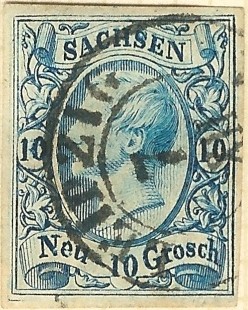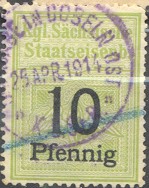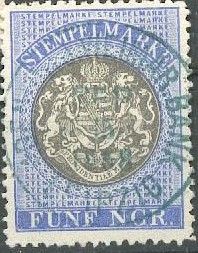



Return To Catalogue - Previous issues - Other German States - Germany - Later issues (1945) for Saxony
Note: on my website many of the
pictures can not be seen! They are of course present in the cd's;
contact me if you want to purchase them: evert@klaseboer.com.
1/2 ngr black on grey 1 ngr black on lilac 2 ngr black on blue 3 ngr black on yellow
These stamps were printed in sheets of 120 stamps.
Value of the stamps |
|||
vc = very common c = common * = not so common ** = uncommon |
*** = very uncommon R = rare RR = very rare RRR = extremely rare |
||
| Value | Unused | Used | Remarks |
| 1/2 ngr | RR | *** | Misprint 1/2 ngr black on blue: RRR (only 120 stamps
printed) For use on local letters, 5,100,000 stamps printed |
| 1 ngr | RR | *** | 5,700,000 stamps printed |
| 2 ngr | RR | R | 2 shades of blue. 2,200,000 stamps printed |
| 3 ngr | RR | *** | 2,350,000 stamps printed. |
Cancels:

So-called 'Vollgitterstempel' (full grid cancel); this cancel was
introduced on 11 March 1852. They appeared with numerals in the
center in December 1852.

Numeral cancel with number in the center (Nummergitterstempel)

An essay of this issue in brown and black with no value
inscription
I have also seen so-called Hirschfeld essays, made by the firm Hirschfeld in 1900 to commemorate their 100 years of existance. These are similar to the above stamp (without value inscription), but in black on coloured paper: I've seen black on grey, black on yellow, black on green, black on lilac etc. Probably the above bi-coloured essay was also made at the same time.

Most likely a forgery; the lettering is slightly different. Also
note the (unusual) purple cancellation.
1/2 ngr black on grey 1 ngr black on lilac 2 ngr black on blue 3 ngr black on yellow 5 ngr red 10 ngr blue
These stamps were printed in sheets of 100 stamps.
Value of the stamps |
|||
vc = very common c = common * = not so common ** = uncommon |
*** = very uncommon R = rare RR = very rare RRR = extremely rare |
||
| Value | Unused | Used | Remarks |
| 1/2 ngr | *** | ** | 17,705,000 stamps printed |
| 1 ngr | *** | ** | 17,345,000 stamps printed |
| 2 ngr | *** | *** | 5,980,000 stamps printed |
| 3 ngr | R | ** | 7,880,000 stamps printed |
| 5 ngr | RR | R | 1856; different shades of red exists; 1,090,000 stamps printed |
| 10 ngr | RRR | RRR | 1856; 250,000 stamps printed. |
The printer of these stamps (Druckerei Meinhold) was not too careful and many stamps with white spots, folds double prints etc. were returned by the individual post offices. In 1918 all of these were sold and are known in Germany as 'Makalatur'.
Forgeries exist of the 5 ngr and 10 ngr. The line after 'N' of 'SACHSEN' should be vertical and not slanting (according to 'The forged stamps of all countries' by J. Dorn). In the right hand corner there should be 3 pearls in the hand-like structure and in the left hand corner there should be 4 pearls. In both the 5 g and the 10 g, the 'N' of 'SACHSEN' should have its right vertical stroke parallel to the line to the right of it (belonging to the frame surrounding this word).


(Pictures of a stamps that I believe to be genuine; 4 pearls on
the left and 3 pearls on the right, line behind 'N' not slanting)
Examples of forgeries:



Forgeries, line behind "N" of "SACHSEN"
slanting backwards. In the 5 g, the two "5"s in the
side panels are more slanting to the right in the genuine stamps.
Note the "SEBNITZ i/S" cancel on one of the forgeries.
I've only seen the above forgeries with cancel '32'. If I'm not mistaken, these forgeries are known as 'Neuruppin' forgeries (the firms Gustav Kühn and Oehmigke & Riemschneider?).
This forgery is described in Album Weeds. It is engraved as the genuine stamps. There are only three balls in the 'hand' in the upper left corner. The mouth is too large, there are small lines on the ears (almost dots). There are many more small differences, such as: the 5 vertical lines in front of the 'N' of 'Neu' are all thick except the innermost one which is smaller (in the genuine stamps, only the outermost line is thicker). There should be a line between the 's' and 'h' of 'Grosch', but it is absent in this forgery.
I've been told that the next stamps are Fournier forgeries. They are mentioned in his 1914 pricelist, but not shown in 'The Fournier Album of Philatelic Forgeries'.
It can be distinghuished most easily by the left hand side outline, which is doubled for some distance between the '10' and the bottom of the stamp. This forgery is also described in Album Weeds as the second forgery of the 10 g. Note also that the leaf above the 'N' of 'Neu' is at a larger distance from the label containing this word than in the genuine stamps (this leaf should almost touch the label).


(Two other primitive forgeries of the 10 g value)

Forgery of the 10 g value. "-" in front of bottom
"10" too long, "SACHSEN" written in different
lettering.


(Sperati 'Proof' in black of type 'A')
The forger Sperati made forgeries of the 10 g value (type A and B). Both types have the left '0' of '10' very smudged. It also has a part of a line outside the lower left frame (part of an adjoining stamp?). There is a small opening in the frame in the upper left corner. Reproduction 'B' has an additional white spot at the right bottom hand side of the 'N' of 'Neu'. A picture can be found on http://www.seymourfamily.com/rfrajola/Sperati/speratiindex.htm:

(Sperati's reproduction 'B', image obtained from the above
mentioned website)
The book 'Praktisches Handbuch der Freimarken des Konigreichs Sachsen' by Friedrich W.Dieck, 1921 (see also http://www.archive.org) mentions that the forger Oswald made a 'Lichtdruck' (collotype) forgery of the 10 g stamp. This forgery seems to be quite rare.
3 Pfennige green 1/2 Ngr orange Slightly different types
1 Ngr red 2 Ngr blue 3 Ngr brown 5 Ngr grey (many shades from bluish to lilac)
The stamps have perforation 13 and appeared on 1st July 1863 (printed in sheets of 100).
Value of the stamps |
|||
vc = very common c = common * = not so common ** = uncommon |
*** = very uncommon R = rare RR = very rare RRR = extremely rare |
||
| Value | Unused | Used | Remarks |
| 3 p | * | R | 10,850,000 stamps printed |
| 1/2 ngr | * | * | 17,100,000 stamps printed |
| 1 ngr | * | * | 15,175,000 stamps printed |
| 2 ngr | * | *** | 4,870,000 stamps printed |
| 3 ngr | * | *** | 5,870,000 stamps printed |
| 5 ngr | *** | R | Shades of colour; 1,200,000 stamps printed |
The 1 ngr, 2 ngr and 3 ngr were issued in colors corrresponding to the German-Austrian Postal Union convention.
1 Ng red 2 Ng blue 3 Ng yellow 5 Ng violet 10 Ng green
In 'Philatelic Forgers, their Lives and Works' by V.E.Tyler, it is stated that the stamp forger Alwin Nieske ordered forgeries of the above 10 Ng envelope stamps from the firm of Salm in Plauen from 1872 to 1874.
1/2 Ng orange 1 Ng red 2 Ng blue 3 Ng brown 5 Ng lilac
Fournier has made forgeries of these stamps. Here some of the cancels he used on these forgeries (taken from a Fournier album):

(Reduced sizes)
Example



(Reduced size)
I have seen the following values:
Inscription 'Kgl. Sachsische Staatseisenb.': 5 p red and black, 10 p green and black, 20 p olive and black, 30 p green and black, 40 p orange and black, 50 p lilac and black, 60 p blue and black, 70 p lilac and black, 80 p yellow and black, 90 p brown and black, 1 M grey and black, 2 M green and black.
Inscription 'Sachsische Staatseisenb.', with 'Sachsicsche Staatseisenb.' and value in black: 10 p green and black, 20 p olive and black, 50 p lilac and black, 60 p blue and black, 70 p brown and black, 80 p orange and black, 90 p brown and black, 1 M grey and black, 2 M green and black, 3 M blue and black, 4 M brown and black, 5 M orange and black.
Click here for more German railway stamps



(Inscription 'STEMPELMARKE')
The following values exist: 1 Ngr green and grey, 2 Ngr brown and grey, 2 1/2 Ngr yellow and grey, 2 1/2 Ngr green and grey (1873), 5 Ngr blue and grey, 10 Ngr red and grey, 15 Ngr orange and grey and 1 Th violet and grey, 2 Th violet and grey, 5 Th violet and grey and 10 Th gold and violet(?).
The following values exist (value always in black, colour of the stamp brown): 10 p (1895), 20 p, 25 p, 40 p, 50 p, 60 p, 80 p, 1 M, 1 1/2 M, 2 M, 5 M, 10 M, 20 M, 50 M, 100 M, 500 M and 1000 M.
(sorry, no picture available yet, if you posess a picture, please contact me!)
The following values were issued (value always in black): 10 p green and red, 20 p green and red, 50 p green and red, 1 M red and lilac, 1 1/2 M red and lilac, 2 M red and lilac, 5 M red and lilac, 10 M violet and red, 20 M violet and red, 50 M violet and red, 100 M blue and green and 500 M blue and green.